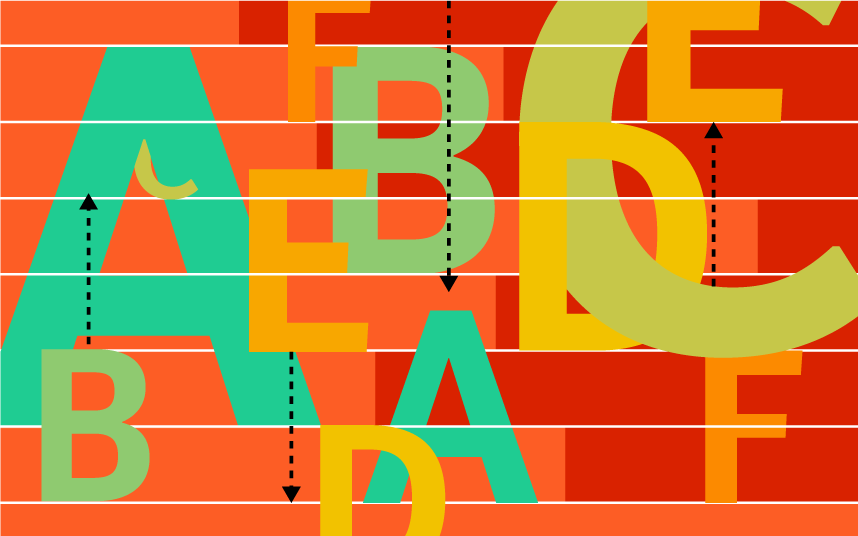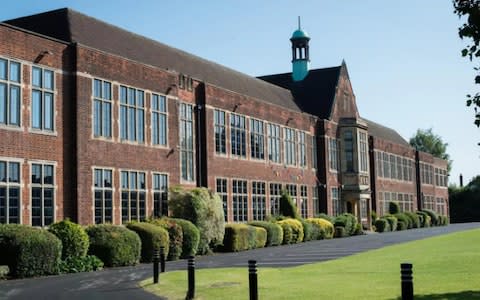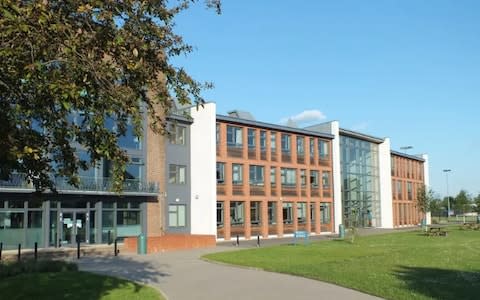Top grammar schools in the UK according to GCSE league tables

The Tiffin Girls' School in Kingston upon Thames is at the top of the tree when it comes to GCSE performance among grammar schools in 2018.
The girls' school achieved a 100 per cent rate of pupils gaining five or more A*-C/ 9-4 grades at GCSE last year, including English and maths.
It was one of 47 grammar schools in the country to achieve such a success, but the Tiffin Girls' School is set apart by having the highest Progress 8 measure among them.
Our interactive league table allows you to search these results by specific school and compare schools of your choice to one another.
There are 164 grammar schools in the Department for Education's data, upon which this table is based.
Search for your school or town to find out where it ranks

While scores of grammar schools managed to get all of their students achieving over five top GCSES, only a handful managed to gain a Progress 8 measure greater than one.
As well as the Tiffin Girls' School, these are Upton Court Grammar School (Slough), Queen Elizabeth's School (Barnet), Nonsuch High School for Girls (Sutton), the Henrietta Barnett School (Barnet) and Kendrick School (Reading).
The Progress 8 measure aims to capture the progress a pupil makes from the end of primary school to the end of key stage 4.
It is calculated for each pupil by comparing their Attainment 8 score (pupils' attainment across eight qualifications) with the average Attainment 8 scores of all pupils nationally who had a similar starting point.
A score of zero means that pupils on average do as well at key stage 4 as other pupils across England who got similar results at the end of key stage 2 - so a positive score means that their progress outpaced that of similar students who used to be at their level.
This year’s GCSE exam results revealed that one fifth - some 20.3 per cent - of entries across all schools nationally achieved an A/7 or higher. 66.6 per cent of entries received a C/4 grade or higher.
This year, changes in GCSE regime meant that a new numerical system was used to mark several subjects.
In an attempt to toughen up GCSEs, the new system uses grades one to nine, rather than from A* to G - with anything above a seven being level to anything above an A in the old system.

If you're thinking of sending your teenager to a grammar school, here's the top 10 in the country, according to last year's GCSE results.
10. Wilson's School, Wallington
Status: Grammar school for boys aged from 11 to 18
Percentage of pupils achieving 5+ A*-C/9-4 (including English and Maths):100 per cent
Progress 8 score: 0.92
About the school: Founded in 1615, this is one of the country's oldest state schools. Catering for around 1,200 boys, it has a high academic ethos, as well as an excellent extra-curricular programme - sport and music are particularly strong. There's a strong pastoral system, which aims to instill the core values of respect, tolerance, cooperation, service to the community, personal achievement and, most importantly, hard work. Appropriately, the school's motto is: "Non Sibi Sed Omnibus" - "not for oneself, but for all". All major religions are represented in the student body, with over 40 languages spoken.
9. Loreto Grammar School, Altrincham
Status: Catholic grammar school for girls aged from 11 to 18
Percentage of pupils achieving 5+ A*-C/9-4 (including English and Maths): 100 per cent
Progress 8 score: 0.94
About the school: Part of the worldwide Loreto community, it was founded by the Sisters of Loreto in 1909. Today, it educates about 1,000 girls. Embracing the Loreto values of Justice, Truth, Sincerity, Joy, Excellence and Internationality, the school aims to nurture young Catholic women who will go on to take leadership roles in local, national and global society. All pupils are expected to participate in daily worship and to complete the Student Leadership Accreditation Award, which helps them to identify and practise a variety of leadership skills through participating in the School Council, charity and sport as well as serving as form representatives.
8. St Olave's and St Saviour's Grammar School, Orpington
Status:Grammar school for boys aged from 11 to 18
Percentage of pupils achieving 5+ A*-C/9-4 (including English and Maths): 100 per cent
Progress 8 score: 0.94
About the school: The legacy of brewer Henry Leeke enabled it to open its doors on Michaelmas Day 1561. Today, around 1,000 pupils attend the school, and girls have been admitted into the Sixth Form since 1998. Here, there's a Christian ethos, which embraces the values of duty to oneself, duty to others, duty to the school and duty to the community. There's also a strong emphasis on cultural enrichment, through activities such as music, chess, drama, debating and the Duke of Edinburgh Awards. Academic standards are high. However, the school was recently criticised for apparently forcing out pupils who were unlikely to get top grades at A-Level.
7. Wallington County Grammar School, Wallington
Status: Grammar school for boys aged from 11 to 18
Percentage of pupils achieving 5+ A*-C/9-4 (including English and Maths): 100 per cent
Progress 8 score: 0.97
About the school: Founded in 1927, this 1,100-strong boys' school welcomes girls in the Sixth Form. Embracing core values of compassion, courage, commitment and creativity, the school's motto is "Per Ardua Ad Summa" - "through difficulties to the heights". As well as being committed to academic success, Wallington County also encourages its pupils to be sportsmen and women, artists, musicians, actors and debaters. Activities include various sports, school orchestras and ensembles, and the Duke of Edinburgh Awards.
6. King Edward VI Camp Hill School for Boys, Birmingham

Status:Grammar school for boys aged from 11 to 18.
Percentage of pupils achieving 5+ A*-C/9-4 (including English and Maths): 100 per cent
Progress 8 score: 1
About the school: It first opened its doors in Camp Hill, Birmingham, in 1883, before moving to Kings Heath in 1956, where it shares a campus with its sister girls' school. Currently educating around 800 boys, the school claims to be one of the highest achieving and best equipped schools in the country. However, according to the headmaster Martin Garrod, "for most of the boys, most of the time, priorities usually lie elsewhere - in sport, music, drama, chess and the breathtaking range of activities and opportunities available at Camp Hill". Sports facilities are impressive: four rugby pitches, two cricket pitches and four tennis courts. And many of the sports teams led by professionals in their fields.
5. Kendrick School, Reading

Status:Grammar school for girls aged from 11 to 18
Percentage of pupils achieving 5+ A*-C/9-4 (including English and Maths): 100 per cent
Progress 8 score: 1.07
About the school: Founded in its current form in 1877, it takes its name from Reading cloth merchant John Kendrick, who left a £12,500 bequest to the towns of Reading and Newbury to provide employment and education for the poor. Some of this money was later used to found the school. In 2006, it joined with Reading Girls' School to form the Kendrick Federation, with the aim of raising standards of education for girls in the area. Two years later, the two schools formed the Girls' Trust for Educational Excellence and Enterprise. Kendrick School, which has about 700 pupils, specialises in science, mathematics and languages. Extra-curricular activities on offer include an Amnesty International group, a gardening group and a book club.
4. Nonsuch High School for Girls, Sutton
Status:Grammar school for girls aged from 11 to 18
Percentage of pupils achieving 5+ A*-C/9-4 (including English and Maths): 100 per cent
Progress 8 score: 1.13
About the school: It prides itself on providing a broad and balanced curriculum for around 1,300 pupils, and on outstanding teaching. As well as striving for academic excellence, girls are encouraged to contribute to other aspects of the school and the wider community through sporting, creative and fund-raising activities. According to the head teacher, the aim is to prepare pupils to be "perceptive and caring global citizens who are not only prepared for the 21st century but who understand its complexity". The school is especially proud of its music and drama departments.
3. Queen Elizabeth's School, Barnet

Status:Grammar school for boys aged from 11 to 18
Percentage of pupils achieving 5+ A*-C/9-4 (including English and Maths): 100 per cent
Progress 8 score: 1.16
About the school: Founded in 1573, Queen Elizabeth's is consistently placed at or near the very top of the national league tables. It is currently educating more than 1,200 boys. According to its website, the school's formal mission is "to produce young men who are confident, able and responsible". Far from being an "exam factory", it encourages pupils to follow their passions - so there are many extra-curricular activities including robotics, debating, sports and chess. All sixth-formers are required to do voluntary service - helping charities, local businesses or primary schools.
2. Upton Court Grammar School, Slough
Status:Non-denominational grammar school for boys and girls aged from 11 to 18
Percentage of pupils achieving 5+ A*-C/9-4 (including English and Maths): 100 per cent
Progress 8 score: 1.19
About the school: Previously known as Slough Grammar School, it is currently home to around 1,000 pupils. According to its website, the school "values its tradition of excellence and honours all of those who have, through their academic credentials and personal commitment, become outstanding members of the community and role models for the next generation". As well as an impeccable academic record, Upton Court offers a wide range of extra-curricular activities and clubs - including photography, choir, netball, robotics, creative writing and crochet.
1. The Tiffin Girls' School, Kingston upon Thames

Status:Grammar school for girls aged from 11 to 18
Percentage of pupils achieving 5+ A*-C/9-4 (including English and Maths): 100 per cent
Progress 8 score: 1.21
About the school: Currently catering for around 1,100 girls, this school was founded in 1880. The school's motto is "sapere aude" - literally: dare to be wise - though in this context it urges pupils "to be brave enough to take risks". There are six houses: Bebbington (Red), Flavell (Yellow), Schofield (Blue), Watson (Green), Orford (Orange) and Nicolle (Purple) - and everyone can choose from a wide range of activities, including sports, music, subject clubs and debating.
Additional research: Demi Whitnell
Notes
Secondary schools have been ranked by the percentage of pupils achieving five or more A*-C/ 9-4 or equivalents including 9-4 in both English and mathematics GCSEs. If schools are tied on this metric, the Progress eight measure is used as a secondary ranking.

 Yahoo News
Yahoo News 